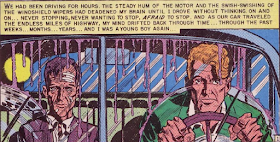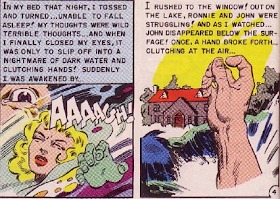 After a close study of the first twenty-one episodes of Alfred Hitchcock Presents with teleplays by Robert C. Dennis, I have determined that a particular strength of his was his ability to take a short story and tighten its structure, adding or consolidating scenes as needed to reinforce key themes and strengthening the plot. A good example of this is "The Equalizer."
After a close study of the first twenty-one episodes of Alfred Hitchcock Presents with teleplays by Robert C. Dennis, I have determined that a particular strength of his was his ability to take a short story and tighten its structure, adding or consolidating scenes as needed to reinforce key themes and strengthening the plot. A good example of this is "The Equalizer."The story upon which this episode is based is also titled "The Equalizer," written by C.B. Gilford and published under the pen name Roy Carroll (a house pseudonym used by other authors as well) in the October 1957 issue of Alfred Hitchcock's Mystery Magazine. Gilford has another short story in the same issue, which is surely why this one was published under a pseudonym.
 |
| "The Equalizer" was first published here |
On Thursday afternoon, Wayne does not show up for an office meeting and Eldon feels sick, certain that the man is with Louise. Eldon telephones home but gets no answer. He leaves work early and visits a bar, then goes home at the usual time; Louise claims to have been at home all day.
On Saturday night, Eldon and Louise attend the weekly party at the country club. Eldon watches from the bar as Louise slips outside and Wayne follows soon after. When Major returns, Eldon throws a drink in his face and challenges him to a fight. Major refuses and Eldon is fired. An attempt at a punch ends in Eldon being knocked out. At home, Louise chastises her husband and admits to an affair with Wayne; she is upset that Eldon has ruined things between her and her lover and she walks out.
 |
| Martin Balsam as Eldon |
In the opening paragraphs of the story, Gilford traces "the principle of the equalizer" through history, from the stone-tipped spear in the primeval jungle to the atomic bomb in WWII. The real equalizer of the story, however, turns out not to be a gun but rather Eldon's cunning, which allows him to exact revenge on his more physically powerful adversary.
Charles Bernard Gilford (1920-2010) was born in Kansas City, MO, and had early success as an author when his novelette "The Liquid Man" was published as the cover story in the September 1941 issue of Fantastic Adventures (read the story here). After this auspicious beginning, Gilford's name disappears from the lists of story credits until 1953; he was graduated from college in 1942 and served in the Air Force from 1942 to 1945. He began work as a college teacher in 1947 and would continue teaching speech, English, drama, theatre, and creative writing for the rest of his career. He married and had four children.
 |
| Norma Crane as Louise |
As much as Gilford may have focused on plot, Robert C. Dennis knew how to improve on his sources. His teleplay for "The Equalizer" is directed by James Neilson and features Martin Balsam as Eldon and Leif Erickson as Wayne; the episode was broadcast on CBS on Sunday, February 9, 1958.
 |
| Leif Erickson as Wayne |
Scene two takes place upstairs at the country club, where we see Wayne dancing with Louise as Eldon chats with Sloan at a table. Sloan mentions that he will be playing golf with Wayne soon and Eldon assures him that Sloan will win because Wayne is a salesman, inferring that salesmen let the customer win. "You never play a customer's game, do you, Eldon," replies Sloan, foreshadowing later events. After the music stops and the dance is done, Louise flirts openly with Wayne and visibly is disappointed when he turns his attention to another attractive woman.
Scene three picks up where the short story begins, with Eldon and Louise in their bedroom after the party. Scene four takes place in the office, as Wayne visits Eldon, just as in the story, but scene five replaces the Thursday office meeting with another scene in the country club's locker room, where Wayne has failed to show up for tee time with Sloan. Eldon overhears his colleagues speculating that Wayne is with another man's wife and, as in the story, Eldon calls home.
 |
| Eldon on the roof in the last scene |
In the next scene, Louise leaves Eldon as they talk at home. A new scene is then added, where Eldon is at the office packing up personal items from his desk. Sloan comes in and Eldon comments that Wayne's actions affected Louise and "just made her cheap;" this is the reason Eldon believes he has to fight Wayne. Sloan tells him to stay, keep his job and forget about Wayne and Louise, but Eldon refuses and says that he has to settle with the larger man.
 |
| Wayne's gun hand appears |
For the second time, Dennis uses the show's title in the dialogue; first, it was the golf club; now, it is the lack of fear of dying. Wayne chooses guns for the upcoming duel and tells Eldon to meet him on the roof of the Kay Corporation building, not a hotel rooftop as in the story.
 |
| Wayne on the roof |
From the shadows, a hand emerges holding a gun. Wayne steps out of the shadows and Eldon turns, sees him, and is shot twice. Later, Wayne brings the police to the roof. Wayne's claim of self defense is belied by Eldon's lack of a gun, and in the final shot we see Eldon lying dead on the rooftop, blood on his shirt from the fatal bullet wound in his chest.
"The Equalizer" improves on its source story because Robert C. Dennis tightens up the structure, limits the number of scene changes, and compresses the time span of events. There is increased focus on "the equalizer"of the title; it is the golf club, the lack of fear, the gun, and--finally--Eldon's cunning plan and understanding of his opponent's cowardice. The final scene, especially, benefits from good direction, lighting and staging, and there are strong performances by everyone in the cast. In the end, Eldon Marsh is more concerned with honor than with material success; he defends his wife's honor and his own by sacrificing his life on a lonely rooftop.
 |
| Dudley Manlove as Harris |
Top billing in the cast goes to Leif Erickson (1911-1986) as Wayne Phillips (Wayne Major in the story). Born William Anderson, he began his career as a singer and trombone player before trying vaudeville and ending up in Hollywood. His movie career began in 1933. He first appeared on TV in 1949 but remained busier in movies until 1957, when he began to take regular roles on TV. In addition to "The Equalizer," he was seen on two episodes of The Alfred Hitchcock Hour. He was on Night Gallery twice and his TV career ended in 1984.
 |
| The last shot, with Eldon |
Eldon's unfaithful wife is played by Norma Crane (1928-1973), who was born Norma Zuckerman in New York City. Also in the Actors Studio, her screen career began with a TV appearance in 1951. She was seen in three episodes of Alfred Hitchcock Presents and also appeared on Thriller, as well as many other TV shows. Her most visible role was as Golde in the 1971 film version of Fiddler on the Roof. She died of cancer at age 44.
 |
| Robert Riordan as Sloan |
Eldon's sympathetic boss, Harvey Sloan, is played by Robert Riordan (1911-1968), whose movie career began in 1947 and who started showing up on TV in 1957. This was his only appearance on the Hitchcock show.
"The Equalizer" is available on DVD here or may be viewed for free online here. Read a humorous review of the episode here. Thanks to Peter Enfantino for providing a scan of the original story.
Sources:
"C(harles) B(ernard) Gilford." Contemporary Authors Online. Gale, 2002. Web. 14 Apr. 2016.
"The Equalizer." Alfred Hitchcock Presents. CBS. 9 Feb. 1958. Television.
"The FictionMags Index." The FictionMags Index. N.p., n.d. Web. 14 Apr. 2016.
"Galactic Central." Galactic Central. N.p., n.d. Web. 17 Apr. 2016.
Gilford, C. B. "The Equalizer." Alfred Hitchcock's Mystery Magazine Oct. 1957: 19-24. Print.
Grams, Martin, and Patrik Wikstrom. The Alfred Hitchcock Presents Companion. Churchville, MD: OTR Pub., 2001. Print.
In two weeks: "Guest for Breakfast," starring Joan Tetzel (who?)!





































